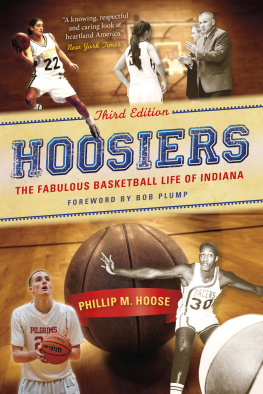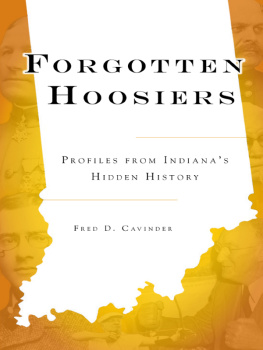This book is a co-publication of
INDIANA UNIVERSITY PRESS
Office of Scholarly Publishing
Herman B Wells Library 350
1320 East 10th Street
Bloomington, Indiana 47405 USA
iupress.indiana.edu
Telephone 800-842-6796
Fax 812-855-7931
and
INDIANA HISTORICAL SOCIETY PRESS
Eugene and Marilyn Glick Indiana
History Center
450 West Ohio Street
Indianapolis, Indiana 46202-3269 USA
Indianahistory.org
2014 by James H. Madison
All rights reserved
No part of this book may be reproduced or utilized in any form or by any means, electronic or mechanical, including photocopying and recording, or by any information storage and retrieval system, without permission in writing from the publisher. The Association of American University Presses Resolution on Permissions constitutes the only exception to this prohibition.

The paper used in this publication meets the minimum requirements of the American National Standard for Information SciencesPermanence of Paper for Printed Library Materials, ANSI Z39.48 1992.
Manufactured in the
United States of America
Library of Congress
Cataloging-in-Publication Data
Madison, James H.
Hoosiers : a new history of indiana / James H. Madison.
pages cm
Includes bibliographical references and index.
ISBN 978-0-253-01308-8
(cloth) ISBN 978-0-253-01310-1
(ebook) 1. Indiana History. I. Title.
F526.M219 2014
977.2 dc23
2013049889
1 2 3 4 5 19 18 17 16 15 14
PREFACE
Hoosiers: An Introduction
THIS IS A BOOK ABOUT A PEOPLE TWO CENTURIES IN THE making. They call themselves Hoosiers, these citizens of Indiana. They think, many of them, that they are different from other Americans. Who are they? What kind of people were they two centuries ago? What are their stories?
I begin with the word Hoosier. Generations of curious researchers have failed to identify its origin or meaning. Many have offered serious speculation and light amusement. One oft-told story is attributed to the Hoosier poet, James Whitcomb Riley. After a brawl in a pioneer tavern that included eye gouging, hair pulling, and biting, a bystander reached down to the sawdust-covered floor and picked up a mangled piece of flesh. Whose ear? he called out. Perhaps its just as well to have a mystery around something so important.
The word was widely used both in conversation and in print by the early 1830s, including in a widely cited 1833 poem titled The Hooshers Nest. Two years later a newcomer to Richmond explained in a letter to family back home in Pennsylvania that old settlers in Indiana are called Hooshers and the cabins they first lived in Hooshers nests. She added, It takes a year to become a Hoosher. Near La Porte about the same time, a traveler in the land of the Hooshiers wrote that the term has now become a soubriquet that bears nothing invidious with it to the ear of an Indianian. Hoosiers have retained the nickname into the twenty-first century, when state records showed twenty-six hundred businesses using Hoosier in their official name. Its true that at times some have ascribed negative connotations to the word, using it to suggest
This book is not about the word but rather about the development of Hoosier traditions. On the Indiana frontier, settlers created a way of life that they passed down to later generations. They came to value individual freedom. They distrusted government, even as they demanded that government remove Indians, sell them land, and bring democracy. Down to the present, Hoosiers have remained wary of government power and careful to guard their tax dollars and their individual freedoms (even the freedom to ride a motorcycle without a safety helmet).
Indianas traditions always mixed with change. New issues such as slavery entered politics and brought Civil War, the states most searing experience. Railroads, cities, and factories replaced pioneer log cabins and spinning wheels. By the late nineteenth century, Hoosiers had evolved into a moderate, some would say conservative, people. Most believed careful and slow change to be better than revolutionary change. Evolutionary change became the Indiana way. By the late twentieth century, some challenged Indianas traditions as outmoded and asserted the necessity for more rapid response to a changing world.
THIS BOOKS ORIGINS
This book began as my attempt to update The Indiana Way, a history I published in 1986. But simply updating that book proved unwise.books about race in recent years makes it clear that such stories are not only about African Americans but about all Hoosiers.
Also influencing the writing of this book is the world in which we now live. The twenty-first century has brought different perspectives. We are more attuned to environmental questions, for example. We know today that an understanding of the climate, land, and water before and after humans arrived is essential to our present. We are also more open to understanding people and movements outside our immediate experience. Today we can easily condemn the Ku Klux Klan, but we can also recognize the deep historical contexts and genuine beliefs of those who joined the hooded order in the 1920s. We are more aware today of global connections. Long before Indiana became a state, people here engaged in transatlantic trade and spoke languages other than English. We know that state and local politics and government are more important than ever, whether the issues are economic development, quality education, or recent social concerns such as same-sex marriage and abortion. All have roots in Indianas past.
HISTORY FOR ADULTS
Hoosiers are nice people so nice that they sometimes stick their heads in the sand and hope that contentious issues will simply go away. Some still believe that we should tell only happy stories that celebrate our past. That kind of old-fashioned history is better suited to fourth-graders who need civic role models. (Fourth grade is the last time the state requires the teaching of Indiana history.) This book is for adults.
Even adults naturally seek history that comforts us and makes us feel good. We imagine a golden age when life was better than today. The centennial of statehood in 1916 featured this kind of comfort as it celebrated a past of linear progress from savagery to civilization. One dissenter was Indiana University professor James Woodburn, a member of the Centennial Commission, who advised Hoosiers that Our failures teach us as much as our successes, and we must confess that this history which we celebrate has its seamy side. A century later, there is much for Hoosiers to celebrate but not all of this book will give comfort.
We like stories too about heroes and villains, stories that shape a binary history of good and bad. There is room in this book for leaders such as George Rogers Clark, William Conner, Oliver P. Morton, Benjamin Harrison, Madam C. J. Walker, and Eli Lilly. All were flawed, of course, and thus they are more interesting than the cardboard figures of heroic stories. We all have our favorite Hoosiers. Mine is Abe Lincoln, who grew up on the Indiana frontier in most ordinary circumstances yet went on to become the greatest American of all time. He too was imperfect, as he so well knew.



 The paper used in this publication meets the minimum requirements of the American National Standard for Information SciencesPermanence of Paper for Printed Library Materials, ANSI Z39.48 1992.
The paper used in this publication meets the minimum requirements of the American National Standard for Information SciencesPermanence of Paper for Printed Library Materials, ANSI Z39.48 1992.





